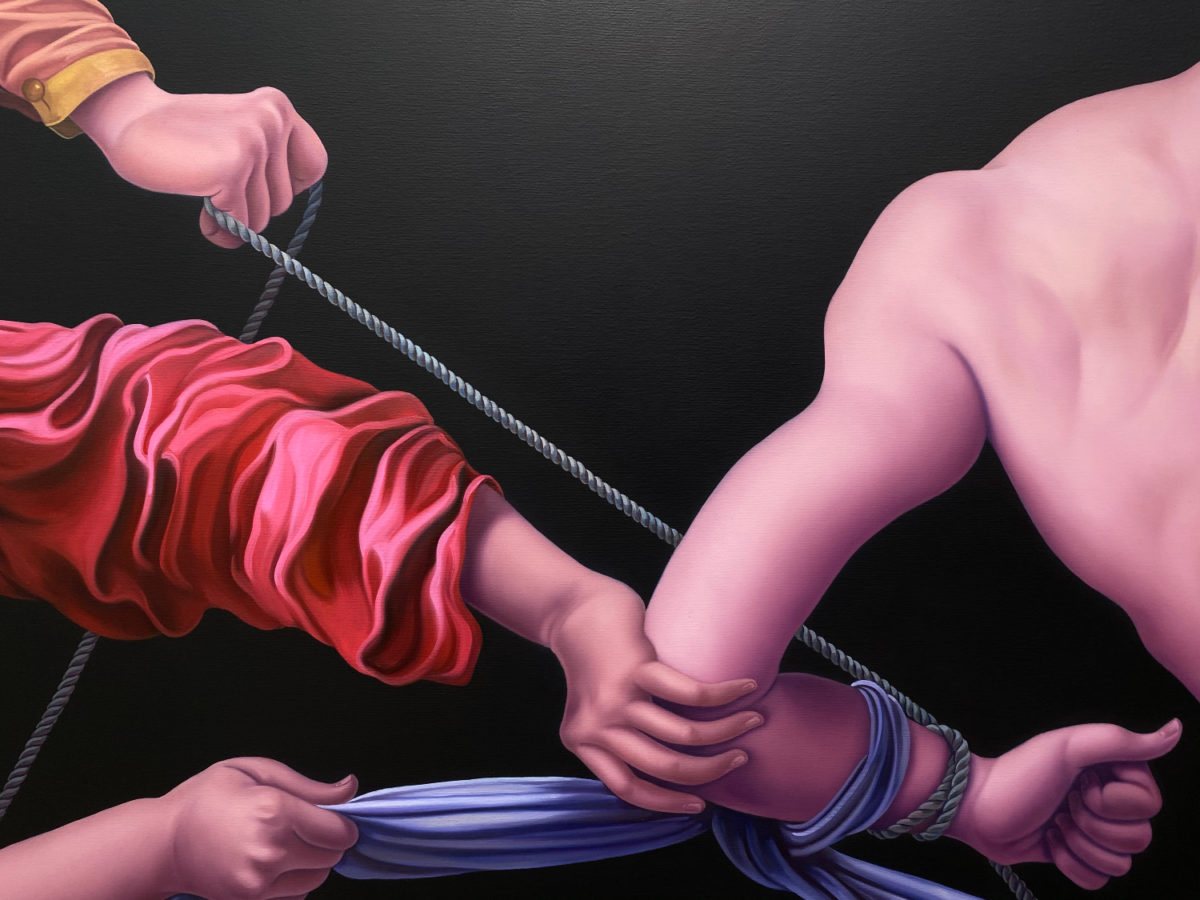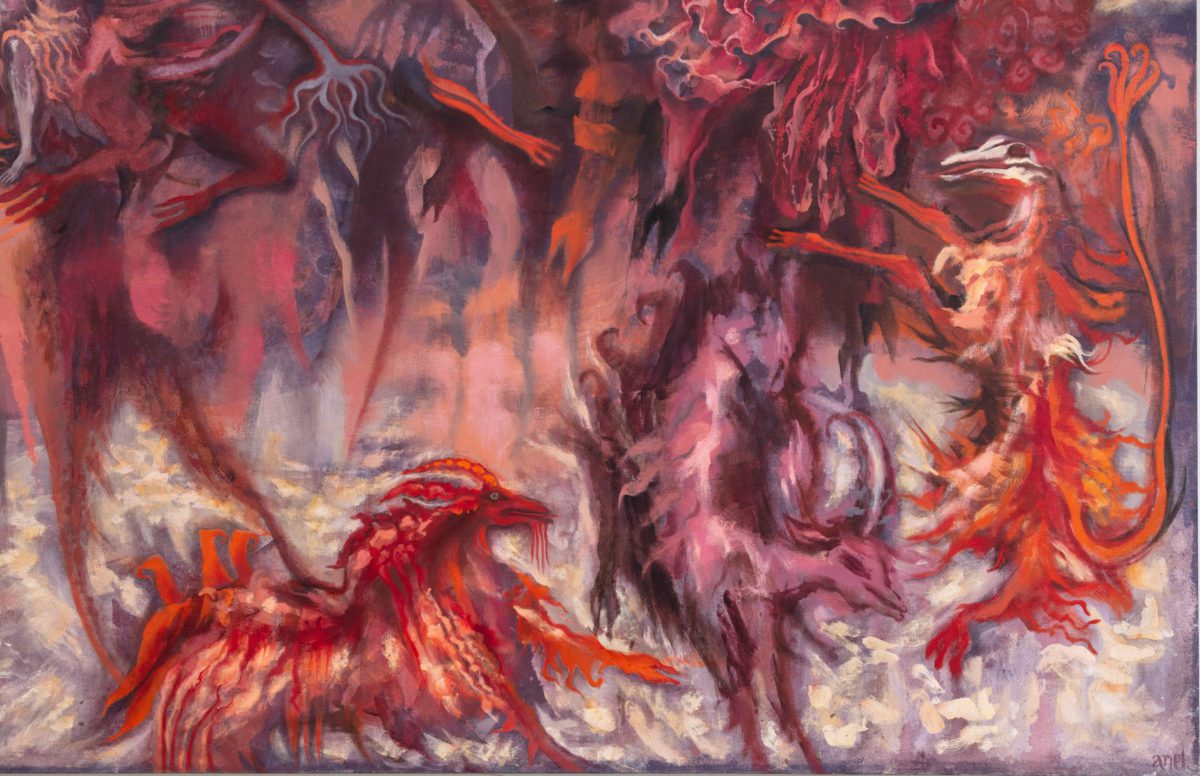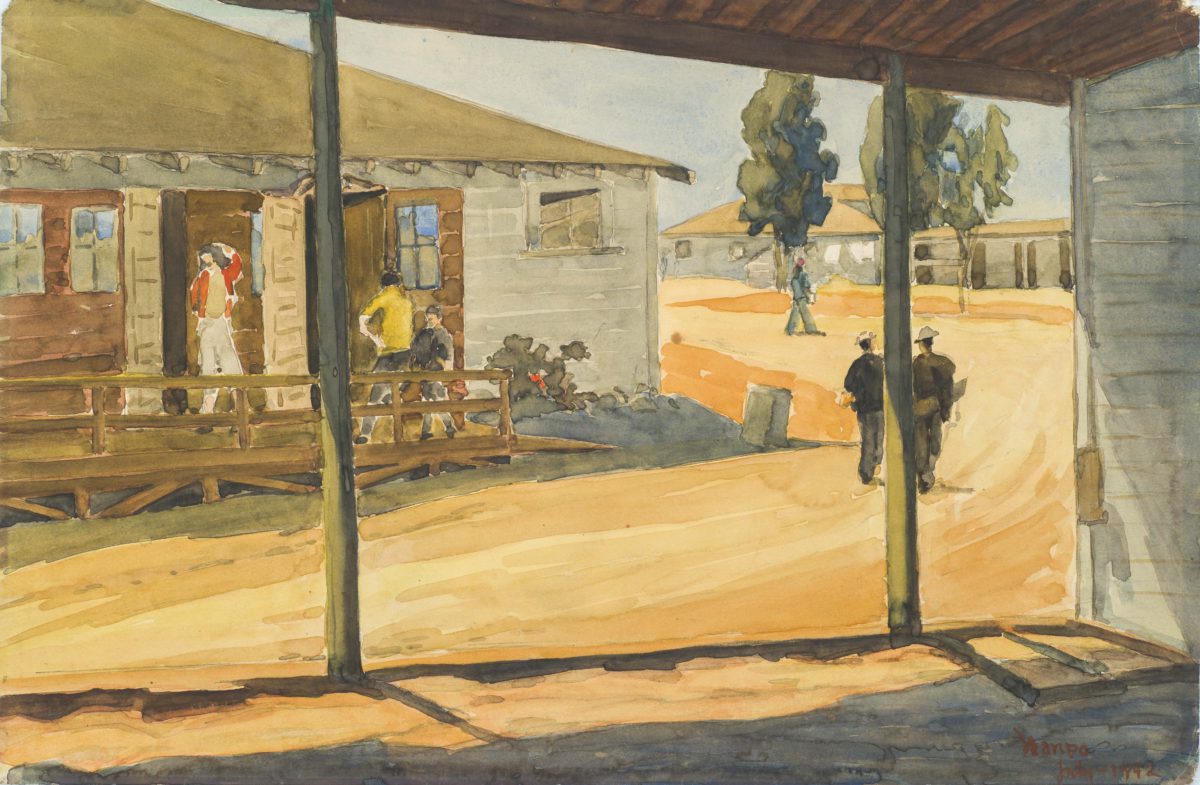Night Gallery’s 10th Anniversary opener, Majeure Force, and Blum & Poe’s 5,471 miles

The core concept of group exhibitions is simple: the pursuit of thematic cohesion. When executed well such exhibitions can accommodate a plurality of experiences through a singular vision.
Topical group exhibitions are not uncommon in Los Angeles, what is novel is that current anxieties have become the curatorial starting point. In June 2020, Night Gallery opened its tenth anniversary program Majeure Force with a roster of 41 artists unfurled in two back-to-back exhibitions. Drawing from the contractual phrase which makes exceptions in light of unforeseen circumstances, the title also represents a self-congratulatory nod to the gallery’s continued dominance in the global avant-garde.
A confluence of twisting, grappling hands against a shallow pictorial plane in Jesse Mockrin’s Blinded, ridiculed, pitied (2020) is arguably Night Gallery’s most poignant display of restraint. Mediated through a subversion of Rococo, the oil painting conveys a cyclical self-determination as the figures, cropped and severed, play out an eternal tug-of-war. This tension parallels the nearby Italian officer’s firm grip on Amanda Knox’s arm in Cara Benedetto’s digital print, TV painting (Amanda) (2020) and carries into Rose Marcus’ Central Park (Bench Man) (2017), where the head of a park visitor is decapitated by a veil of black velvet. This performance of body parts spills over from the first iteration of Majeure Force with Sean Townley’s Red Ankhhafs (2016), consisting of three, red cast aluminium copies of the bust of an ancient Egyptian prince.
Night Gallery’s two-part exhibition is overwhelmingly figurative. At its most bare, illness is about the body. In Daniel T. Gaitor-Lomack’s Where the Hood At? We Right Here (2019)—a precarious arrangement of found detritus—“hood” draws on the shorthand for neighborhood and suggests the imprecision attached to the geopolitical landscapes of Black spaces. That it also refers to apparel becomes evident in the next room, where a hoodless sweatshirt hangs unceremoniously on the back wall of the gallery space. Alluding to David Hammons’ In the Hood (1993), the levity of the wordplay masks the more somber undercurrent of a crudely beheaded subject, acting as a metonym for violence against Black bodies.
Swaying from powerfully enforced realism to emotional mysticism, Night Gallery’s curation is a dynamic appraisal of the complexities of viral anxiety. While such analysis may come across as a projection, it is almost impossible to view art now without the tinge of coronavirus seeping into the surface of interpretation. This is only exacerbated by the intrinsically disjointed performance of group exhibitions.

The perils of attempting to portray this complexity as purposeful, however, are made evident at Blum & Poe. Individually, the works in 5,741 miles—the title refers to the distance between the gallery’s spaces in Tokyo and Los Angeles—are well-conceived. Like Night Gallery, the title bridges the range of works through its comparable acknowledgement of the limitations of exhibiting amid changing transport and travel restrictions.
While several artworks speak to present conditions, many are simply token works of the gallery’s repeatedly shown artists. Friedrich Kunath’s pithy instruction to “cancel everything” inscribed on a painting of the same title effectively underscores the generally light tone of Blum & Poe’s curation. Darren Bader’s installation of objects touched by the bygone glamor of old Hollywood perhaps unwittingly encapsulates the impermanence of material wealth that accompanies earlier artistic representations of pestilences. Bader’s fetishistic pairings of famous accoutrements such as Bob Keeshan’s gloves atop Neil Young’s staple gun sitting opposite Hugh Hefner’s glue stick in a basket once owned by Doris Day emerge as a sculptural vanitas translated fluidly into the gallery space. While yet another group exhibition with tenuous links between artists often goes under the radar, Blum & Poe’s particular address—centered on the pandemic’s limitation of international travel—reveals its uninterest in engaging outside of its narrow, elite audience.
The limitations of coronavirus have cultivated a new precedent for the arts in the virtual realm. Viewers can access a 360-digital capture, self-guided interactive tour of ICA LA’s Ree Morton and Ann Greene Kelly exhibition on the museum’s website. MOCA has produced a range of online content from progressive voices including the anti-mass incarceration group, In Plain Sight, and a virtual studio visit with prolific filmmaker, Arthur Jafa. Art spaces have also opened previously inaccessible archives. Hauser & Wirth published a digital screening of the documentary about post-minimalist Eva Hesse in May to coincide with the reprint of Eva Hesse: Diaries. The high attendance of these events suggests a public desire for further online engagement.
While what we are experiencing might feel like an anomaly, a setback in the normal flow of existence, in reality it has granted us a point of meaningful departure.
5,471 miles, July 21-August 15, 2020
Blum & Poe, 2727 S La Cienega Blvd, Los Angeles, California
(310) 836 2062
Majeure Force, Pt 1, June 27-July 25, 2020
Night Gallery, 2276 E 16th St, Los Angeles, California
(323) 589 1135




